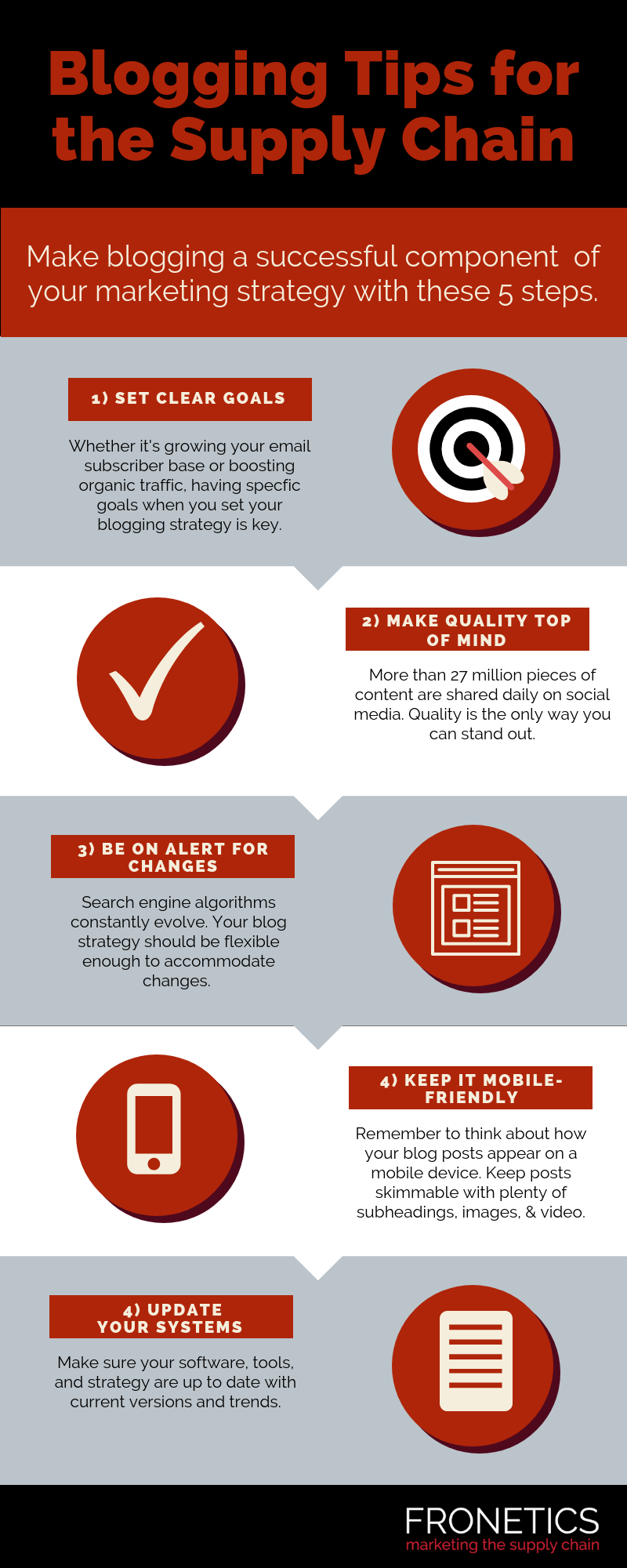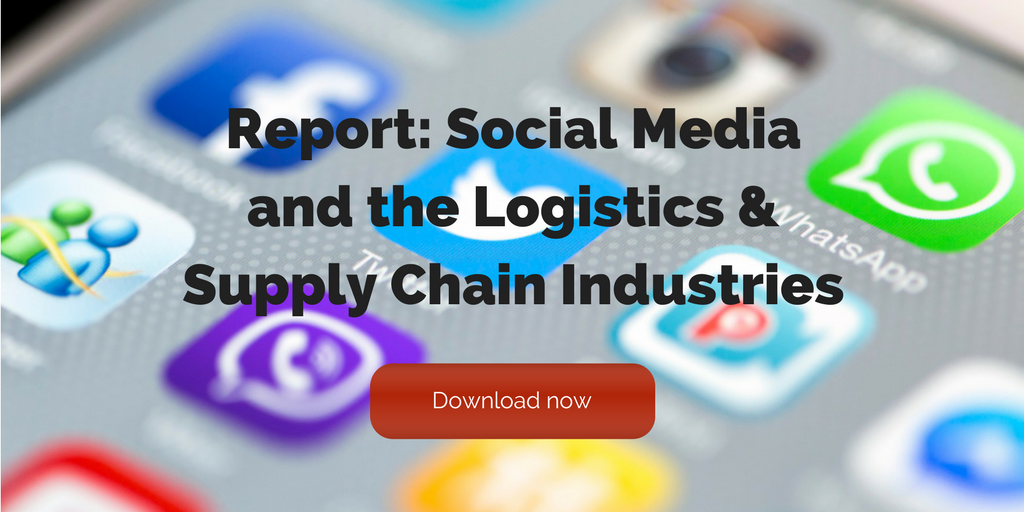
by Fronetics | Jan 17, 2019 | Blog, Content Marketing, Logistics, Marketing, Supply Chain
Blogging should be a central part of your content marketing strategy. Here are our top tips for creating and sustaining a successful supply chain blog in 2019.
Highlights:
- Blogging needs to be a central part of your content marketing strategy.
- Focus on quality over quantity.
- Make all posts mobile-friendly.
It’s the start of a new year and the perfect time to start setting goals and strategizing how to achieve them. Hopefully, blogging is a big part of your strategy for 2019 — after all, supply chain companies should make blogging a central part of their content marketing strategy for all kinds of reasons.
[bctt tweet=”At last count, users share 27 million pieces of new content on social media every single day. Twenty-seven million!” username=”Fronetics”]
Making your supply chain blog stand out from the pack isn’t always easy. That’s why we created the infographic below. Read on for our top 5 supply chain blogging tips for 2019.
5 tips for your supply chain blog

(Made with Canva)
1. Set clear goals
We know, this one sounds obvious. But you’d be surprised how often marketers overlook this seemingly simple step or settle for general, vague goals. It’s true that blogging can have all kinds of positive impacts for the supply chain, but that doesn’t mean that you should just be blogging without a clear, documented set of goals specific to your business.
Whether it’s growing your email subscriber base, boosting organic traffic, or generating more qualified leads, having specific goals in mind when you set your blogging strategy is key. For one thing, it lets you target your efforts and generate content that is focused on achieving a specific result or set of results. Furthermore, having objectives allows you to be far more effective in evaluating your results, including measuring blogging ROI, and tweak your strategy accordingly.
What are your top three goals for your supply chain blog in 2019? Let us know in the comments!
2. Make quality top of mind
Ponder this for a minute: At last count, users share 27 million pieces of new content on social media every single day. Twenty-seven million. In a world of skyrocketing quantity, quality is ever-more important. There’s a huge amount of pressure on supply chain marketers to produce a constant stream of content, but the sad truth is, if you’re not producing high-quality, substantive content, you’re wasting time and energy.
For supply chain companies in particular, it’s crucial that every piece of your content be well-researched, clearly written, focused, and trustworthy. We know that producing consistently high-quality content isn’t easy, but, trust us: if you invest the time and energy to make your content stand out, you will see the results. To get you started or keep you focused, check out our guide to creating good content for logistics and supply chain marketers.
3. Be on the alert for changes
Particularly when it comes to search engine optimization (SEO), changes happen fast these days. In August of 2017, Google updated its algorithm, continuing a set of changes we’ve been watching for a while now. Voice searches are becoming increasingly prevalent, and researchers estimate that by 2020, 50% of all searches will be voice queries.
As these changes continue to happen, it’s crucial that your strategy is lithe and flexible, ready to adapt to a quickly shifting climate. This means keeping abreast of conversations going on in the industry, following blogs you trust and respect, as well as tracking your own results, and being alert to changing trends.
4. Keep it mobile-friendly
You don’t need researchers to tell you: people are increasingly receiving and reading content on their phones. Whether it’s social media, emails, or blogs, mobile usage continues to skyrocket as devices become more and more ubiquitous and user-friendly.
What does this mean for supply chain blogs? Of course, your website needs to have a visually attractive and accessible mobile version, but it’s also helpful to think about your blog posts in terms of how they appear on a phone. Keep your posts skimmable, with plenty of subheadings to orient the reader, and absolutely include video whenever possible.
5. Make sure your systems are up to date
We keep coming back to the reality of the rate of change these days. It can be exhausting and overwhelming for marketers to keep pace. Take the opportunity of the new year to make sure all your blogging-related tools are updated and running the current software.
As you’re keeping your tools fresh, it’s also a good time to make sure your procedures are running smoothly and are at a pace with the current marketing climate. This means evaluating responsibilities and results within your team, ensuring that your editorial calendar is serving you well, and taking a look at your data collection and reporting methods.
Bonus: What not to do in 2019
These might seem obvious, but again, you’d be surprised how may marketers fall victim to these blogging “don’ts.” We figured it bore repeating.
- Don’t: attempt to post content that doesn’t reflect your business’ “comfort zone.” Stick to what you know, and do it well.
- Don’t: copy and paste text or images from other blogs. Using other content for ideas is great. Copying it verbatim is verboten.
- Don’t: post at irregular intervals. Creating a content schedule and sticking it is key to establishing a loyal following and boosting your credibility.
What goals do you have for your supply chain blog this year?
Related posts:


by Fronetics | Dec 12, 2018 | Blog, Content Marketing, Logistics, Marketing, Social Media, Supply Chain
Our most-viewed social media posts confirm there’s only one thing that stays the same with social platforms: they’re always changing.
Today, more than ever, companies are turning to social media to engage with customers and reach new audiences. But staying current with updates and new technologies is no easy task for marketers.
2018 was the year of video. From the soaring popularity of Insta Stories and Snapchat to the continued success of YouTube, users want to watch content (over reading it). In fact, video is the most popular form of content being consumed online today — and it shows no sign of slowing down.
[bctt tweet=” From the soaring popularity of Insta Stories and Snapchat to the continued success of YouTube, users want to watch content (over reading it). In fact, video is the most popular form of content being consumed online today — and it shows no sign of slowing down.” username=”Fronetics”]
Here are the top 10 social media posts in 2018, including why (and how ) to start implementing video into your content marketing strategy.
Top 10 social media posts in 2018
1. 10 Social Media Statistics for B2B Marketers 2018
Social Media Examiner’s 10th annual study, 2018 Social Media Marketing Industry Report, surveyed more than 5,700 marketers from across the world in a variety of industries — including manufacturing, industrial goods, and a variety of other B2B verticals. Here are some of the most relevant social media statistics from that survey for supply chain and logistics marketers. Read full post
2. An Example of Successful Social Media in Supply Chain Management
Sometimes, a success story can be a powerful motivator. FIFA and Adidas have been extremely successful in using social media in supply chain management. Here’s how it works for these organizations and why your business should consider it. Read full post
3. 10 Tips for Using Instagram for Business
Recent research on social media use shows that 66% of brands now use Instagram. It’s the second-most used platform by businesses, up from fourth in 2017. If you’re considering using Instagram for your business, which you should be, here are some tips for getting started. Read full post
4. Video: Social Media Trends for 2018
As always, good content will be as important as ever. With over one million new-data-producing social media users each day, high-quality content is the only way to stand out from the masses. But we also think you should pay attention to a few social media trends that we have highlighted in the following video. We’re certainly planning to adjust our strategy and those of our clients to consider these things. Read full post
5. 4 Things Your Business Should Do in Light of Facebook News Feed Changes
Mark Zuckerberg once again rocked the world on January 11 — at least for businesses — when he announced that Facebook News Feed was evolving to include less public content, meaning content from Pages of businesses, brands, and media. The algorithm now prioritizes posts from friends and family (over public posts) and those that “spark conversations and meaningful interactions between people.” Here’s how you should change what you’re doing in response. Read full post
6. Infographic: Social Media Statistics Your Business Needs to Consider When Publishing Content
A strong social media presence is key to successful marketing in 2018. Social media is simply unavoidable these days. So, you jumped on board and you’re posting and tweeting. You’re creating content. You’re learning about search engine optimization and how to improve your rankings. But you’re still not reaching the audiences you were hoping to attract. What’s going wrong? Read full post
7. What Supply Chain and Logistics Marketers Need to Know About Organic Reach on Facebook
In a recent social media news post, we mentioned that Facebook was experimenting with an Explore Feed feature. You may or may not have heard about how this might affect businesses’ ability to achieve organic reach on Facebook. Read full post
8. Facebook Boosts Local News, Twitter Launches Sponsored Moments, and More Social Media News
Updates to the most popular sites have included longer character counts, more advanced conversational skills with chatbots, and new tools for easier sharing. All of these changes are working to improve user experience and help keep users active on the biggest sites. Read full post
9. Facebook Updates News Feed, Instagram Allows User to Send Live Videos, and More Social Media News
I’m sure by now you have heard about the updates to Facebook’s News Feed that are having major impacts on business pages’ organic reach. But the changes don’t stop there. Twitter, Snapchat, and Instagram are trying to follow Facebook’s lead and enhance their user experience. Through updates that include video counts, enhanced data collection, and recommended posts, social media is working overtime to make sure its active users are staying active. Read full post
10. 5 Ways to Improve Your YouTube Marketing Strategy
I’ve written a lot about YouTube and how the supply chain should be leveraging it as a marketing tool. Of course, I don’t recommend just creating videos at random and throwing them up on your channel. Like any content or platform, you should approach YouTube strategically. Read full post
Related posts:


by Fronetics | Dec 11, 2018 | Blog, Content Marketing, Logistics, Marketing, Supply Chain
Our most-viewed content marketing posts indicate that marketers are seeking solutions to improve their content marketing programs.
Supply chain and logistics marketers have seen the benefits (and successes) of content marketing. It is the most cost-effective method to earn leads and sales. Why? Because content marketing focuses on the way B2B byers are making purchases, finding and evaluating content through online searches.
[bctt tweet=”Content marketing focuses on the way B2B byers are making purchases, finding and evaluating content through online searches.” username=”Fronetics”]
There is a trend with our most-viewed content marketing posts this year: innovative ways to improve content marketing strategies. From increasing brand awareness to improving SEO, marketers are looking to get their content in front of the right audiences.
Here’s a look at our top content marketing posts from this past year, all focused on industry trends and ways to improve your content marketing strategy.
Top 10 content marketing posts in 2018
1. B2B Marketing Trend 2018: Influencer Marketing
You’ve probably heard the buzzword by now: Influencer marketing seems to be on the tip of every marketer’s tongue these days. But the reality is that B2B marketers have been slow to adopt this new marketing trend. Influence 2.0 – The Future of Influencer Marketing Research Report 2017 showed that only 11% of B2B marketers have an ongoing influencer program. Read full post
2. Writing for SEO: Topic Clusters and Pillar Content (NOT Keywords)
I’ve been hinting — more like, emphasizing — in our recent Writing for SEO series that trying to rank for certain keywords in each blog post you publish is a practice on the way out. You may have been wondering what you’re supposed to do instead. This post on topic clusters and pillar content is your answer. Read full post
3. 10 Ways to Grow Brand Awareness Quickly
If you took Psychology 101 in school (or even if you didn’t), you know that people are more likely to buy from brand names they’re familiar with than those they don’t know. This goes for purchasing things like medicine, and for procuring components or parts as part of the supply chain. That’s why so many of our clients come to us looking to build brand awareness as one of their main goals. They want to customers to know about them — and sooner rather than later. Read full post
4. Should Your Business Be Using Linkless Backlinks to Increase SEO?
Linkless backlinks are mentions of your business or brand without a hyperlink to your webpage. In a keynote speech in September 2017, Gary Illyes, a webmaster trend analyst for Google, said:
“Basically, if you publish high-quality content that is highly cited on the internet — and I’m not talking about just links, but also mentions on social networks and people talking about your branding — then you are doing great.” Here’s how to make linkless backlinks work for you. Read full post
5. Writing for SEO: People Are Changing How They Search
Last week, we kicked off our Writing for SEO series by taking a look at how search engines are changing. As we delve further into updated strategies for effective SEO writing for supply chain marketers, this post explores the ways in which people are changing their search behaviors, and what that means for your content. Read full post
6. 3 Questions to Ensure your Content Marketing Strategy Is Sales-Focused
I recently read an article on the Harvard Business Review that discussed pairing your sales goals with your marketing goals. This strikes at the heart of what we do at Fronetics: build a client’s content marketing strategy that will help advance their short- and long-term business goals. It sounds simple, but you have no idea how many organizations’ marketing goals are misaligned with what the larger organization is trying to accomplish. Read full post
7. Infographic: 8 Ways to Grow Brand Awareness Fast
Have you ever noticed how some brands seem to have crept into popularity overnight? You’ve never heard of them, and then, all of sudden, they’re everywhere. Their brand awareness has sky rocketed, and they’re achieving every company’s ultimate goal: Customers know about them. So what’s their secret? Read full post
8. The More Often You Publish Blog Content, the More Leads You’ll Get
Here are Fronetics, most of our clients are sales-driven. If a client’s business goals include earning leads, we are sure to align the client’s content strategy with that objective. One of the most effective ways to increase the number of leads your website attracts is to increase the frequency with which you publish content. Read full post
9. How to Identify Topic Clusters for Your Business
One of the best ways to strategically structure your content is with the topic cluster model, in which broad cornerstone content is contained on pillar pages, and related subtopics are contained in cluster content. Each grouping of subtopics and corresponding pillar page is called a topic cluster. This structure is intended to build authority and influence for your business in the eyes of search engines and visitors. Effectively using a topic cluster structure is the best way to drive relevant traffic to your website. Read full post
10. Video: Why Does Content Marketing Take So Dang Long to Show Results?
You are committed to your content marketing program. You’ve created blog posts, uploaded videos, and collaborated with industry leaders. You may have started noticing an increase in web traffic, social reach, and other engagement metrics like time on page. You’re on the right track! The problem is your lack of leads or sales. Your boss is pressuring you for results, and you’re starting to question your efforts. Are you doing something wrong? Read full post
Related posts:


by Fronetics | Oct 17, 2018 | Blog, Content Marketing, Logistics, Marketing, Strategy, Supply Chain
Wondering whether you should be prioritizing building traffic or optimizing for conversions? Here’s the case for each.
I currently have a client trying to decide what to prioritize: building traffic to his website or optimizing current content for lead conversions. It’s a chicken-and-egg-style debate. If you don’t increase traffic, who will be on your site to convert? But, if you don’t optimize for conversion, what good is traffic to your website?
As with any chicken-or-egg question, there is neither a simple nor a definitive answer. What you should prioritize at any given time is highly individual, and dependent on factors unique to your business. Consider the case for prioritizing each, while evaluating and bearing in mind where your business is in building its online presence.
The egg: the case for prioritizing traffic
Maybe you’re confident the egg came first—after all, in some ways, it’s the obvious answer. Without traffic to your website, there’s not much point in optimizing for conversion, since there won’t be any leads to convert in the first place. According to AudienceBloom founder and CEO Jayson DeMers, there are three main points to the case for prioritizing traffic:
1) Brand recognition
Conversions aren’t the only thing of value that comes from a traffic-heavy website. “Every visitor who makes it to your site will have the chance to see your brand, read your content, and become more familiar with your company,” says DeMers, writing for Forbes. Building traffic to your website lets you reap these benefits, which will naturally drive up your conversions over time.
2) Long-term strategies
Because effective traffic-building strategies pay off exponentially the longer they’re in place, it makes sense to put them first. Giving your SEO and content marketing efforts time to build momentum ensures that you’ll reap the maximum benefits.
3) Optimizing for value
The best way to determine if your conversion strategy is working and how to improve it is to collect and analyze data. A high traffic volume gives you a testing ground. “Without a steady stream of visitors to test,” says DeMers, “you’ll be flying blind.”
The chicken: the case for prioritizing conversions
Maybe you’re one of those people who wonders where the egg comes from in the first place. While it’s true that without traffic, conversions are unlikely, it’s equally true that a website that isn’t optimized for conversions is not to your best advantage. DeMers again sums up the three main arguments for prioritizing conversion optimization:
1) Low investment, high yield
One of the best things about conversion optimization is that, while it does require ongoing efforts, your initial process is relatively cheap and easy. Check out our guide for creating effective landing pages, for example, and you’ll discover that optimizing for conversions doesn’t have to break the bank.
2) Traffic optimization
This is where quality is more valuable than quantity. “Focusing on conversions first instantly makes every visitor to your website more valuable,” says DeMers. Even if your traffic volume isn’t massive, if your conversion rate is higher, you’re ahead at the end of the day.
3) Reinvestment potential
If your business has limited funds to invest in website optimization, prioritize conversions. “Assuming your conversion strategy is successful early on,” writes DeMers, “the extra revenue you’ll generate from all your new traffic will give you more money you can use to invest further — in the realms of both traffic and conversion.”
The scramble: why you should balance your efforts
[bctt tweet=”Whether you chose to place a heavier emphasis on traffic or conversions, you ultimately want balance in your efforts. “If you fully invest in either side without investing at least slightly in the other, you aren’t going to see meaningful results,” points out DeMers.” username=”Fronetics”]
Whether you chose to place a heavier emphasis on traffic or conversions, you ultimately want balance in your efforts. “If you fully invest in either side without investing at least slightly in the other, you aren’t going to see meaningful results,” points out DeMers.
So far, science hasn’t been able to settle the chicken-or-egg question. In the same way, we can’t tell you whether it makes sense for you to put a higher priority on traffic or conversion optimization. But thinking through the case for each should help you decide what makes sense for your business. Just remember not to put all your eggs in one basket.
Related posts:


by Fronetics | Oct 4, 2018 | Blog, Content Marketing, Logistics, Marketing, Strategy, Supply Chain
Guest posting can help you build your reputation as a thought leader, grow your contact list, improve your SEO, and expose your content to new audiences.
At Fronetics, we use guest posting as a part of our own — and many of our clients’ — content strategies. Essentially, we partner with a relevant influencer or company and swap content to post on each other’s blogs. It can be a really effective way to reach new, relevant audiences and provide interesting perspectives and voices to keep your core audience engaged.
What’s so great about guest posting?
Guest posting has all kinds of benefits. Every time you post as a guest, you expose your content to a whole new audience. We talk about the importance of exposure all the time when it comes to content marketing. Your biggest asset isn’t your products or services; it’s your expertise. Guest posting helps you establish your brand as a thought leader.
[bctt tweet=”Guest blogs can be a really effective way to reach new, relevant audiences and provide interesting perspectives and voices to keep your core audience engaged.” username=”Fronetics”]
In addition to posting with industry influencers and peer brands, guest posting for larger publications can be hugely beneficial, for obvious reasons. Not only are you introducing your brand and content to a broad audience, you’re associating yourself with an established authoritative source.
By the same token, having other brands author guest posts on your own blog is a great idea as well. When key influencers write for your blog, they bring their audience directly to you, allowing you to tap into a new and relevant set of prospects. Not only that, by inviting peers to contribute to your content, you’re forging and strengthening relationships within the industry.
Guest posting is great for SEO
We’re always talking about how to improve your SEO. One benefit of guest posting that’s often overlooked is that it can significantly improve your search engine rankings.
Search engines use backlinks from other websites, particularly popular ones, as part of their algorithms that determine how search results are ranked. According to online business expert Sarah Peterson, in a guest article for the Huffington Post, “You can use the opportunity of your guest post to include 1-2 backlinks to strong pieces of content you want to rank for.”
Grow your contact list
We all know that email marketing is hugely effective and profitable, if your contact list is strong and effectively segmented. Another often overlooked benefit of guest posting is that it has the potential to strengthen and enrich your email marketing efforts.
Because you’re being exposed to new audiences, both as a guest blogger and when guests write for your blog, you have the opportunity to target and cultivate new leads from relevant sources. Use guest posts as an opportunity to usher prospects to lead generation campaigns on your own website.
Says Peterson, “if you’re not using this marketing strategy, you could be leaving a ton of email subscribers on the table.”
How do you use guest posting in your content strategy?
Related posts:










